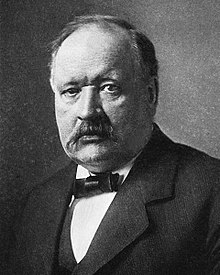Svante Arrhenius | |
|---|---|
 Arrhenius in 1909 | |
| Born | 19 February 1859 Vik Castle, Uppsala County, Sweden |
| Died | 2 October 1927 (aged 68) Stockholm, Sweden |
| Alma mater | Uppsala University |
| Known for | |
| Awards |
|
| Scientific career | |
| Fields | Physics Chemistry |
| Institutions | Stockholm University |
| Doctoral advisors | Per Teodor Cleve[1] Erik Edlund[2] |
| Doctoral students | Oskar Benjamin Klein |
Svante August Arrhenius ForMemRS (/əˈriːniəs, əˈreɪniəs/ ə-REE-nee-əs, -RAY-,[3][4] Swedish: [ˈsvânːtɛ aˈrěːnɪɵs]; 19 February 1859 – 2 October 1927) was a Swedish scientist. Originally a physicist, but often referred to as a chemist, Arrhenius was one of the founders of the science of physical chemistry. He received the Nobel Prize for Chemistry in 1903, becoming the first Swedish Nobel laureate. In 1905, he became the director of the Nobel Institute, where he remained until his death.[5]
Arrhenius was the first to use the principles of physical chemistry to estimate the extent to which increases in the atmospheric carbon dioxide are responsible for the Earth's increasing surface temperature. His work played an important role in the emergence of modern climate science.[6] In the 1960s, Charles David Keeling reliably measured the level of carbon dioxide present in the air showing it was increasing and that, according to the greenhouse hypothesis, it was sufficient to cause significant global warming.[7]
The Arrhenius equation, Arrhenius acid, Arrhenius base, lunar crater Arrhenius, Martian crater Arrhenius,[8] the mountain of Arrheniusfjellet, and the Arrhenius Labs at Stockholm University were so named to commemorate his contributions to science.
- ^ "Per Teodor Cleve". Oxfordreference.com. Retrieved 21 March 2024.
- ^ "Svante Arrhenius: Biographical". Nobelprize.org. Retrieved 21 March 2024.
- ^ "Arrhenius, Svante August". Lexico UK English Dictionary. Oxford University Press. Archived from the original on 27 August 2022.
- ^ "Arrhenius". Merriam-Webster.com Dictionary. Merriam-Webster. Retrieved 16 August 2021.
- ^ "Arrhenius, Svante August" in Chambers's Encyclopædia. London: George Newnes, 1961, Vol. 1, p. 635.
- ^ Dessler, Andrew E. (2021). Introduction to Modern Climate Change. Cambridge University Press. p. 222. ISBN 978-1-108-84018-7.
- ^ Baum, Rudy M. Sr. (2016). "Future Calculations: The first climate change believer". Distillations. 2 (2): 38–39. Retrieved 22 March 2018.
- ^ de Vaucouleurs, G.; et al. (September 1975). "The new Martian nomenclature of the International Astronomical Union". Icarus. 26 (1): 85−98. Bibcode:1975Icar...26...85D. doi:10.1016/0019-1035(75)90146-3.